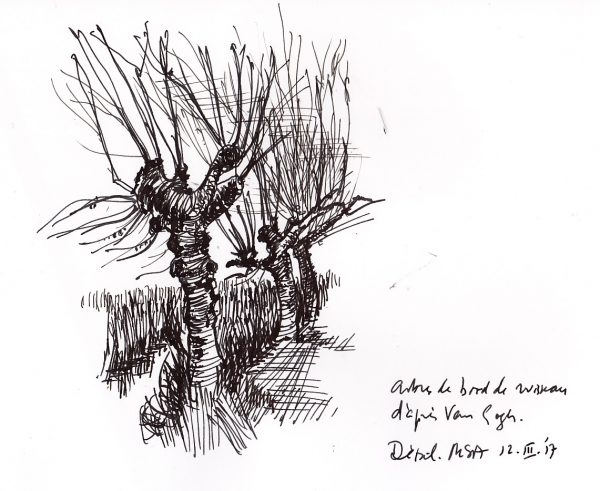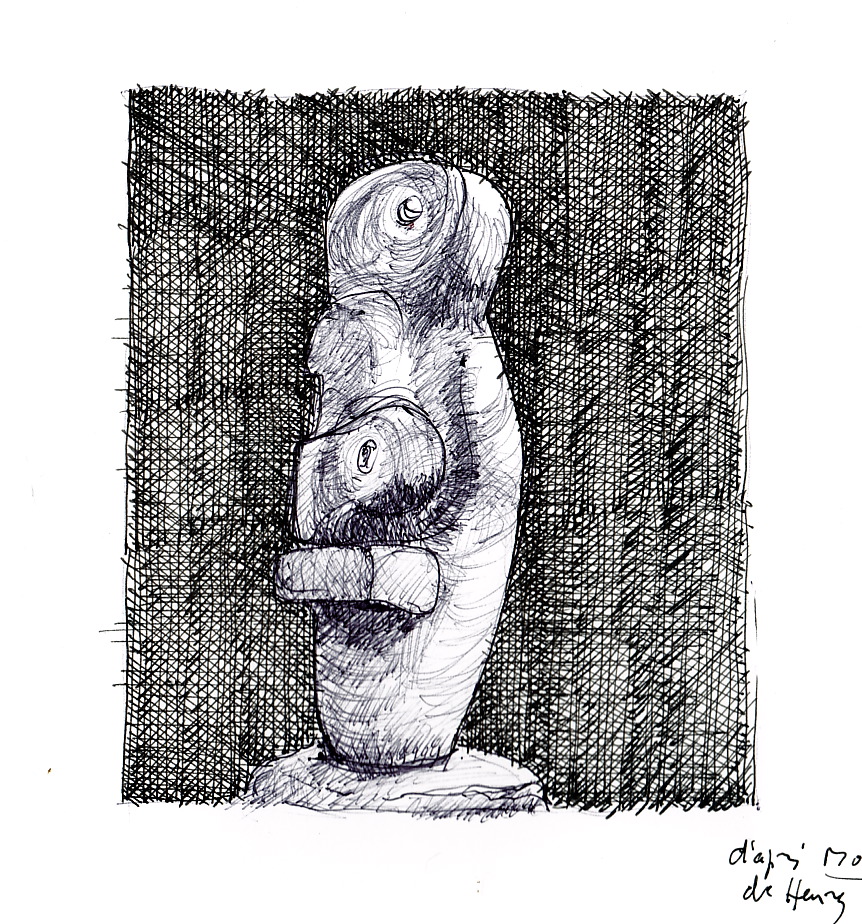Weathering Winter storms in this northern city has given rise to various techniques to deal with the associated claustrophobic symptoms of “cabin fever” (remember Chaplin’s The Gold Rush). One of them, for me, consists of projecting myself into places of differing climes through the sketches of great artists as shown in the feature image (On a village road by Corot), and as discussed in the following examples.
As I try to copy-interpret these original sketches with sketches of my own, I find time to be of the essence in the process that brings forth form through the various steps of developing adequately expressive configurations of line, etc.
As each step articulates the faculties of seeing, drawing, judging, understanding, changing, etc. each one of these faculties contribute to making sketching an exercise in active interpretation … the other and more significant purpose of the interlude!
[alert type=alert-white ]Please consider making a tax-deductible donation now so we can keep publishing strong creative voices.[/alert]
Sketching Sylvia Plath’s “Wuthering Heights Today” – detail
The hunkering down allure of this dry stone constructed shelter has sparked my eye-hand circuitry … the use of a broad nib fountain pen throughout the sketch renders the roughness of the construction toward a remarkable sense of place.
Ref. Plath, Sylvia: Sylvia Plath – Dessins, Éditions La Table Ronde, ca. 2013, pp 19
Sketching David Bradford’s “A city like a divine spark” – detail
Bradford is a graphic designer and publicist turned, after a serious accident, to being a taxi driver, and full time photographer of the N.Y. urban environment. Interspersed among his published photographs of New York, his sketches express his love of the city and the keen rapport sketching can establish between artist and subject. The mastery of eye-hand coordination required by this sketching technic, and my choice of a corner for detail, result in a powerful sense of being present in that place.
Ref. Bradford, David: Drive-By Shootings, Köneman, 2000, pp.(?)
Sketching Canaletto’s “The portico with a lantern” – detail
Canaletto needs no introduction as his depiction of Venice from every possible angle, and urban life situation, is known world wide; his eye for framing the subject allows one to take any detail and turn it into a subject of its own. I have chosen one such detail … the point where building, land form and sea meet … as viewed through a suggested arch opening.
Ref. Constable, W.G.: Canaletto, Catalog of Exhibitions in Toronto, Ottawa and Montreal, 1964-65, pp.83

Sketching Camille Corot’s “Environs de Gênes” – detail
Corot’s place as a master ot the romantic school translates into his preference for natural over urban scenes; here he alludes to the nearness to the port city of Genoa with a single fort like structure, seen between windswept trees, and facing the open sea with its sailboats under a cloudy tormented sky and, in foreground, a land form that seems to extend the wind driven waves over onto dry land … Narry a straight line here!
Ref. Bourret, Claude: Corot – le génie du trait, estampes et dessins, Bibliothèque nationale de France, 1996, pp.51
Sketching Vincent Van Gogh’s “Arbres au bord d’un ruisseau” – detail
For Van Gogh, in his own words, “ drawing is at the root of everything” … Ever since my boyhood I felt an attraction for, if not a kinship with, this artist who carried his emotional state “on the sleeve” of his art so to speak. His drawings reveal his profound sympathy for his subjects whether people or landscapes. The richness of the whole drawing was beyond my ability to hold within myself, but was amenable for me to render, with his characteristic pen strokes, this modest detail: the evocation of tree roots lapping at the nearby brook.
Ref. Google search: Van Gogh drawings, (Vincent Van Gogh – Tree drawings …)

Sketching Henry Moore’s sculpture of “Mother and child”
If I may use a precise expression, I think all of Moore’s work was a search for the “root representation of human form”. His “Mother and Child” is unique in that it stands between his bloc sculptures and his more articulate and known reclining figures. The protruding eye and holding hand of the mother, as well as her out stretched neck and head, hold all the expressive tension of maternal protection this bloc figure can muster.
Since I am sketching from a photograph of the sculpture, and not from a sketch, you may wish to consider this last sketch as a cross between my personal style of drawing and Moore’s own as illustrated in his Sheep Sketchbook; as such it has required considerable time for the process of arriving at a satisfactory formal expression using a ball point pen for the sculpture and a pen for the background and sculpture outline.
Ref.
Compton, Susan: Henry Moore – Exhibition Catalog, Royal Academy of Art, London, 1988, pp.74
Moore, Henry & Clark, Kenneth: Henry Moore’s Sheep Sketchbook, Thames and Hudson, 1980

All sketches credit Maurice Amiel
